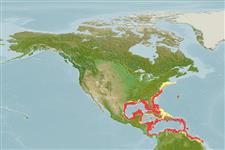>
Scombriformes (Mackerels) >
Ariommatidae (Ariommatids)
Etymology: Ariomma: Greek, ari = very, strength, superiority + Greek, omma = eyes (Ref. 45335).
More on author: Poey.
Environment: milieu / climate zone / depth range / distribution range
Ecologia
marinhas demersal; intervalo de profundidade 0 - 500 m (Ref. 13628). Subtropical; 41°N - 4°N, 98°W - 50°W
Western Atlantic: New Jersey, USA and northern Gulf of Mexico through the Antilles (Ref. 13628) to the Guianas.
Tamanho / Peso / Idade
Maturity: Lm ? range ? - ? cm
Max length : 25.0 cm TL macho/indeterminado; (Ref. 26340); common length : 18.0 cm TL macho/indeterminado; (Ref. 3269)
Espinhos dorsais (total): 12; Raios dorsais moles (total): 15; Espinhos anais 3; Raios anais moles: 14 - 15. Caudal peduncle slender, square in cross section, with 2 fleshy keels along each side (Ref. 26938).
Adults caught in shrimp grounds and deeper shelf areas, but occurrence is sporadic. Juveniles inhabit offshore surface waters, especially around floating weeds. Adults may be restricted to continental margins of the western Atlantic with juveniles found in the Caribbean expatriated from these populations (Ref. 51183). Feeds mainly on benthic crustaceans. An excellent food fish (Ref. 26938).
Life cycle and mating behavior
Maturidade | Reprodução | Desova | Ovos | Fecundidade | Larvas
Oviparous, gonochorous, with pelagic eggs (Ref. 101194).
Robins, C.R. and G.C. Ray, 1986. A field guide to Atlantic coast fishes of North America. Houghton Mifflin Company, Boston, U.S.A. 354 p. (Ref. 7251)
Categoria na Lista Vermelha da IUCN (Ref. 130435)
Ameaça para o homem
Harmless
Utilização humana
Pescarias: pouco comercial
Mais informação
ReferênciasAquaculturaPerfil para aquaculturaEstirpesGenéticaElectrophoresesHereditariedadeDoençasProcessamentoNutrientsMass conversion
ColaboradoresFotografiasStamps, Coins Misc.SonsCiguateraVelocidadeTipo de nataçãoÁrea branquialOutras referênciasCérebrosVisão
Ferramentas
Relatórios especiais
Descarregue XML
Fontes da internet
Estimates based on models
Preferred temperature (Ref.
123201): 15.4 - 26.5, mean 21.8 °C (based on 149 cells).
Phylogenetic diversity index (Ref.
82804): PD
50 = 0.5156 [Uniqueness, from 0.5 = low to 2.0 = high].
Bayesian length-weight: a=0.02042 (0.00784 - 0.05315), b=2.96 (2.74 - 3.18), in cm total length, based on LWR estimates for this (Sub)family-body shape (Ref.
93245).
Nível Trófico (Ref.
69278): 3.4 ±0.45 se; based on food items.
Resiliência (Ref.
120179): Elevada, tempo mínimo de duplicação da população menor que 15 meses (Preliminary K or Fecundity.).
Fishing Vulnerability (Ref.
59153): Low vulnerability (15 of 100).
